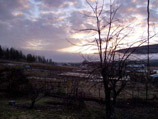OK, let’s get the shovel and head for the garden. Our soil is very sandy unlike the dirt that most people have. When we first moved here from rich dirt and cedar trees to sand and pine trees, I felt like I was living in the desert. Little I knew then how much I would come to love the sandy soil and even the tall pine trees. Every time I dug a post hole I was thankful for sand and not rocks or hard packed dirt. And the best surprise was how well things grew in the light, hot, sandy dirt. I always say, “Just add water and lots of it and you can grow anything.” How true it is. Well, back to cooking dirt. A large enamel pan works great for cooking dirt on the stove. I use the largest roasting pan or turkey cooking pan that I can find. Even an old 8 quart water-bath canner works well. First I put a hollow soup can in the middle of my pan (open both ends with a can opener and remove the outside paper). Place an empty cottage cheese carton upside down on top of the can and begin to shovel moist dirt into your pan and around the can. The carton prevents excess dirt from filling the hollow can. We will fill the can up with water later to help the dirt cook faster and more thoroughly.
Remove the carton, smooth the dirt around the can and level the dirt. Place the pan on the stove and fill the hollow can quickly with water. The water will immediately disappear into the dirt. This is enough water for steaming the dirt. If you add too much water the dirt becomes waterlogged and is difficult to work with. Cover the pan with a lid, or if you do not have a lid, two long strips of foil crimped on tightly works well. On a hot stove, you can begin to see the steam and smell it in about 45 minutes. Continue to cook for another 30 minutes to make sure all weed seed and fungus is killed.
To cook dirt in your kitchen range, just cook it at 350 degrees for about 2 hours or until you have smelled the dirt for 30 to 45 minutes. Remove the pan from the stove and let cool before you dump it in your large plastic tub. Now you are ready to use the dirt in any of your potting soil mixes.











6 Responses to Cooking Dirt for Potting